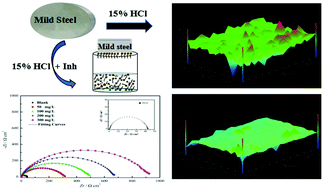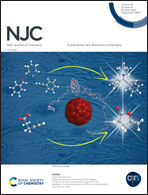9-Substituted acridines as effective corrosion inhibitors for mild steel: electrochemical, surface morphology, and computational studies†
Abstract
Three 9-substituted acridines, namely 9-carboxyacridine (CA), 9-methylacridine (MA), and 9-aminoacridine (AA), were designed and synthesized for the development of effective inhibitors for mild steel corrosion in a 15% HCl solution. The corrosion-resistance ability was tested by weight-loss tests, electrochemical techniques, surface-topography analyses (SEM, SECM, and XPS), and contact angle measurements. The results indicated the inhibition performance followed the order of η(AA) > η(MA) > η(CA), and these acridines acted as mixed type inhibitors with a predominant restrained cathode process. The adsorption of the three acridines on a mild steel surface obeyed the Langmuir adsorption isotherm and involved both physisorption and chemisorption modes. Surface analysis and characterization confirmed the existence of an adsorbed film. Quantum chemical calculations were performed to provide mechanistic insights into the roles of the different substituents (−COOH, −CH3, and −NH2) on the corrosion-inhibition behavior of the three acridines. Molecular dynamics (MD) simulations were carried out to explore the configurational adsorption behavior of these 9-substituted acridines on the Fe(110) surface.



 Please wait while we load your content...
Please wait while we load your content...